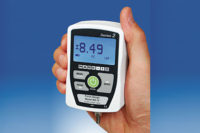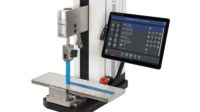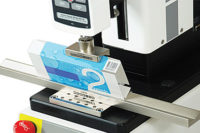Quality 101
Force Gages 101
A force gage is an invaluable tool for a range of applications

A force gage is mounted to a motorized test stand with a pair of wedge grips, configured for a tensile test. Source: Mark-10

Force gages typically have selectable units of measurement. For best performance, select a gage with a capacity as close as possible to the maximum anticipated load. Source: Mark-10

A force gage is a handheld or mountable instrument which integrates a load cell, electronics and display. Source: Mark-10



Why measure force?
The measurement of static compression or tension force yields a wealth of information important for quality assurance professionals in many industries—for example, the peel force of a sealed bag of pretzels, the compression force of a spring, or the pull force of a crimped wire terminal. Without force data, it can be difficult to quantify the quality of certain products, which could result in customer dissatisfaction, safety issues and non-conformance with industry and government standards.
Force gage basics
A force gage is one of the most basic and economical ways of measuring force. Mechanical, spring-based gages have been used for many decades; however, more recent advances in electronics have made digital force gages more popular and affordable. Typically, a digital force gage integrates a strain gage-based load cell with electronics and display, and is battery or AC-powered.
Although the gage can be handheld for less demanding applications, it is considered best practice to mount the gage to a test stand, actuator or other fixture. This type of mounting reduces the influence of operator variability, which can lead to inconsistent readings. Such mounting configurations also help to ensure axial alignment with respect to the load cell shaft. Side loads, which are difficult to avoid in hand testing, can skew the force reading or potentially damage the load cell.
Typical units of force include pound-force (lbF), Newton (N) and kilogram-force (kgF). Force gages are available in a range of capacities and resolutions, reflecting a great number of applications. For example, a food packaging company may need to measure 25 N of force, while a manufacturer of automotive springs may have higher requirements.
With any application, a gage should be selected with a capacity that is as close as possible to the maximum anticipated load. Since accuracy is typically specified as a percentage of full scale, lower force readings are subject to an increasingly large error as a percentage of reading. For example, if the choice of force gages includes 10, 20, 50, and 100 lbF capacity models, and the requirement is for 40 lbF of force, the 50 lbF model is most appropriate. As a general rule, a force gage should be used between 20% and 80% of its capacity, for best performance and avoidance of overloads.
The point of interest in many testing applications is the peak force—that is, the force at which a sample broke, engaged or loosened. This ultimate strength is often how companies gauge the performance of their product. In other cases, force gages are used to apply a specified force to a sample to determine if the sample remains intact and deflects a desired amount.
Advanced force gage functionality
Upper and lower limits, frequently used in the quality control industry, are typically programmable in force gages. On-screen indicators and audible tones alert the operator if the result is too low or too high. Set point outputs can trigger an alarm, buzzer or PLC for integration into a more complex test station.
Beyond simple peak force measurements, continuous data collection is sometimes required for analysis of force versus time or versus distance, when combined with a linear scale or encoder. USB and RS-232 outputs from the force gage may be used to stream data to a PC for tabulation, graphing and further manipulation.
Data memory offers operators the ability to save individual peak readings for later download, a useful convenience if the measurements are taken in a remote location away from a PC. For special applications requiring the capture of continuous data at high speed, or for data collection over a long period of time, certain gages can acquire such data and store it in memory, thus eliminating the need for data acquisition hardware and software.
Measuring the average force over a period of time is a common requirement in the packaging industry, while the external trigger function comes in handy for switch activation force testing—two special measurement modes that are available in some gages.
In large volume testing applications, high throughput and operator ergonomics rank near the top of the priority list. Some force gages address these objectives via a footswitch input for simple activation of multiple functions, such as data output, data storage and zero display. The break detection function can also activate these functions automatically when the gage has detected a sample break, defined as a percentage drop from peak force. In high volume environments, concerns about improper use or sabotage can be allayed via a password. Operator access to sensitive areas can be blocked, such as changing the unit of measurement, manipulating data in memory, and accessing the calibration process.
Calibration
Force gages are generally calibrated utilizing certified dead weights or master load cells with indicators. Multiple load points may be specified during the calibration process, which can help ensure accuracy even when the load cell’s linearity is less than perfect.
The common recommended interval is one year; however, verification of accuracy should be performed more frequently, especially if the gage was dropped or overloaded. Overloads will not always destroy the internal load cell, as gages are generally protected to at least 150% of capacity.
Force testing is an important part of achieving consistent product performance objectives and customer satisfaction. A force gage is an invaluable tool for a virtually limitless number of applications, helping quality control, research, and engineering professionals achieve their product performance objectives.
Looking for a reprint of this article?
From high-res PDFs to custom plaques, order your copy today!








